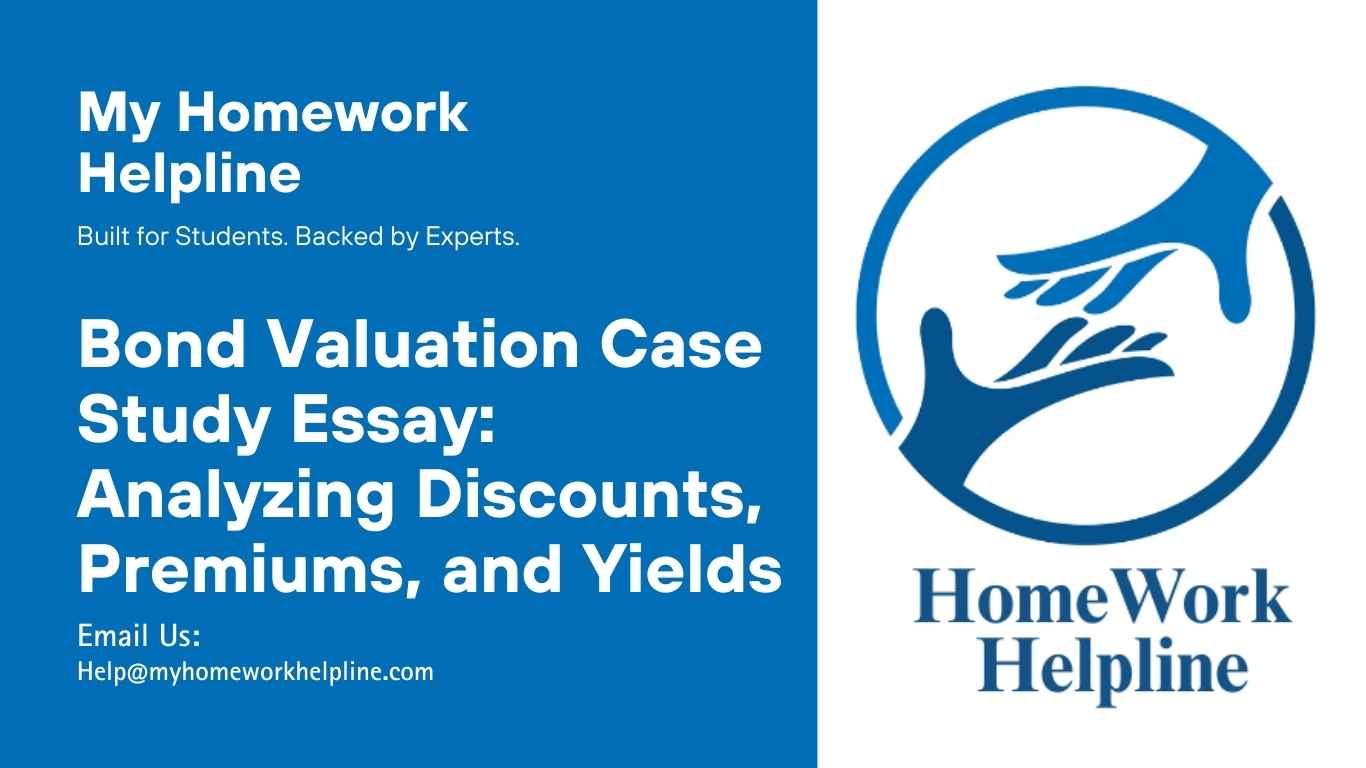Bond Valuation Case Study Essay: Yield, Discounts, and Premium Analysis
E i). What would be the value of the bond described above if, just after it had been issued,
the expected inflation rate rose by 3 percentage points, causing investors to require a
13% return? Would we now have a discount or a premium bond?
The value of the bond with expected inflation would be
PV=C* +
C= * 1000 =100
PV= 100* +
=$837.212
The new bond price of $837.212 is less than $1000, hence the bond is selling at a discount. The higher interest rate has increased the yield on the bond, which makes it less attractive to investors compared to newly issued bonds with higher yields. As a result, the bond’s market price has decreased, and it is now trading at a discount.
Understanding bond valuation, yield calculations, and financial case studies can be challenging. Our expert team provides finance assignment assistance and homework support to help you complete detailed essays and case studies accurately. We guide you through concepts like bond discounts, premiums, total returns, and YTM, making your assignment process easier and ensuring high-quality analysis. Get professional help to enhance your finance essay performance today.
ii). What would happen to the bond’s value if inflation fell and declined to 7%? Would we
now have a premium or a discount bond?
The value of the bond with the expected inflation drop will be;
PV= 100* +
=$1210.71
The new value of the bond is $1,210.71 is higher than the par value of $1,000, hence the bond is now selling at a premium. This is because the lower interest rate has decreased the yield on the bond, which makes it more attractive to investors compared to newly issued bonds with lower yields
iii). What would happen to the value of the 10-year bond over time if the required rate of
return remained at 13%? If it remained at 7%? (Hint: With a financial calculator,
enter PMT, I/YR, FV, and N, and then change N to see what happens to the PV as the
bond approaches maturity.)
Using a financial calculator, entering the following information into the financial calculator: PMT = 100 I/YR = 13 FV = 1,000 N = 10
If we change the number of periods (N) to see how the value of the bond changes over time, we get:
- When N = 9, PV = $ 846.05
- When N = 6, PV = $880.07
- When N = 2, PV = $949.96
We can see as the bond approaches maturity, its value increases towards its par value of $1,000.
Using the same financial calculator inputs as before, but with an I/YR of 7%, we get:
- When N = 9, PV = $ 1195.46
- When N = 6, PV = $1143.00
- When N = 2 , PV = $1054.24
We can see as the bond approaches maturity, its value decreases towards its face value of $1,000.
F i). What is the yield to maturity on a 10-year, 9% annual coupon, $1,000 par value bond
that sells for $887.00? That sells for $1,134.20? What does the fact that a bond sells at
a discount or at a premium tell you about the relationship between and the bond’s
coupon rate?
YTM = C=9/100*1000=90
For the bond selling at $887.00: YTM= =0.1074 =10.74%
For the bond selling at 1134.2 YTM= =0.07176 =7.176%
A bond selling at discount such as the bond selling at $887 means that the bond’s yield to maturity is greater than its coupon rate. This occurs when the bond’s price is below its face value or par value. In contrast, when a bond sells at a premium, such as the bond selling at $1134.2, it means that the bond’s yield to maturity is lower than its coupon rate. This occurs when the bond’s price is above its face value or par value. Therefore, the relationship between a bond’s coupon rate and the yield to maturity is inverse. When the coupon rate is higher than the yield to maturity, the bond sells at a premium. When the coupon rate is lower than the yield to maturity, the bond sells at a discount.
ii). What is the total return, the current yield, and the capital gains yield for the discount
bond? (Assume the bond is held to maturity and the company does not default on the
bond.)
For a bond held to maturity, the total return is given by
Total return = coupon payments + capital gain
Total Coupon payments =*1000*10=900
Capital gains returns =1000-887 =113
Total return=900+113 =$1,013
The bond has a 9% annual coupon payment equivalent to $90 and is currently selling for $887.00. Therefore, the current yield is:
Current yield= *100%
= *100% =10.14%
The capital gains yield is defined as the change in price of the bond divided by the original price of the bond, expressed as a percentage. For a discount bond held to maturity, the capital gains yield is given by
Capital gains yield =
= *100% =12.73%

